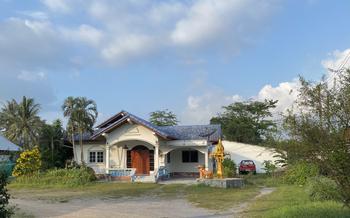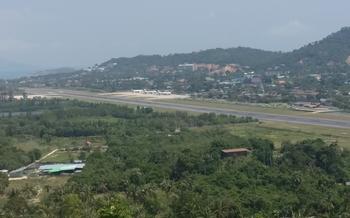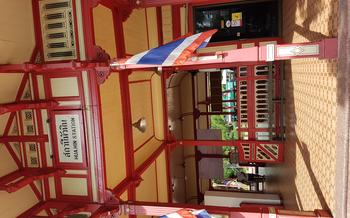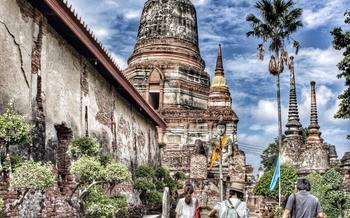
Ko Tao Temple
- Ko Tao Temple: A Sacred Haven Amidst Paradise
- Location and Accessibility: Finding Your Way to Serenity
- Hours of Operation: Planning Your Temple Visit
- Admission and Fees: Supporting the Temple's Preservation
- Dress Code and Attire: Respecting Local Customs
- Photography and Videography: Capturing Sacred Moments
- Exploring the Temple Grounds: A Journey Through History
- Making Offerings and Donations: Showing Gratitude
- Meditation and Reflection: Finding Inner Peace
- Temple Festivals and Events: Celebrating Faith and Culture
- Local Cuisine and Delicacies: A Taste of Tradition
- Souvenirs and Handicrafts: Taking Home a Piece of Ko Tao
- Nearby Attractions: Exploring Ko Tao's Natural Wonders
- Health and Safety Precautions: Ensuring a Safe Visit
- Insider Tip: Uncrowded Serenity
Ko Tao Temple: A Sacred Haven Amidst Paradise
Nestled amidst the to embark on a journey of self-discovery and spiritual enlightenment.
The temple's history dates back to the early 19th century, when a group of devout Buddhist monks sought refuge on the island and established this sacred space. Over the years, the temple has undergone several renovations and expansions, but its essence remains unchanged, embodying the principles of peace, compassion, and devotion.
Architecturally, the Ko Tao Temple showcases a unique blend of traditional Thai and Chinese influences. Its towering stupas, adorned with intricate carvings and vibrant colors, create a visually stunning spectacle. The temple's interior is equally captivating, featuring intricate murals depicting scenes from Buddhist mythology and the life of Buddha.
The Ko Tao Temple is not merely a place of worship; it is a vibrant community hub where religious ceremonies and festivals are held throughout the year. Visitors are welcome to participate in these events, immersing themselves in the local culture and gaining a deeper understanding of Buddhist traditions.
To ensure a respectful and harmonious visit, it is essential to adhere to proper temple etiquette. Remember to dress modestly, remove your shoes before entering the temple, and maintain a respectful demeanor. Refrain from touching or climbing on religious statues or objects, and avoid causing any disturbance or disruption.
Location and Accessibility: Finding Your Way to Serenity
Situated on the serene shores of Ko Tao, the temple invites visitors to immerse themselves in its sacred ambiance. To reach this haven of tranquility, one can embark on a scenic journey by boat, enjoying the mesmerizing views of the turquoise waters and lush greenery that surround the island. Alternatively, a leisurely drive along the coastal roads offers a chance to admire the island's captivating landscapes.
Upon arrival, ample parking is available for both cars and motorbikes, ensuring visitors can conveniently leave their vehicles and begin their spiritual exploration. For those who embrace the beauty of nature, a scenic hiking trail beckons, leading through verdant forests and providing glimpses of the temple's majestic spires amidst the tropical foliage.
Hours of Operation: Planning Your Temple Visit
The Ko Tao Temple welcomes visitors daily, inviting them to immerse themselves in its sacred ambiance. The temple's doors are typically open from 8:00 AM to 6:00 PM, offering ample time to explore its serene grounds and participate in religious ceremonies. During the peak tourist season, which falls between November and April, the temple may extend its hours to accommodate the influx of visitors. It's always advisable to check the temple's official website or contact the local tourist information center for the most up-to-date operating hours.
While the temple is open throughout the day, there are certain times that offer a more serene and contemplative experience. Early mornings, before the tourist crowds arrive, provide a tranquil atmosphere for meditation and reflection. Alternatively, late afternoons, as the sun begins to set, offer a magical glow that illuminates the temple's intricate architecture.
Advance reservations or bookings are not required for visiting the Ko Tao Temple. Visitors can simply arrive at the temple during its operating hours and begin their exploration. However, for guided tours or special ceremonies, prior arrangements may be necessary. It's recommended to inquire about guided tour availability when planning your visit to ensure a comprehensive and insightful temple experience.
Admission and Fees: Supporting the Temple's Preservation
Visiting the Ko Tao Temple is a free and rewarding experience. The temple does not charge any entrance fees or require donations, relying solely on the generosity of visitors to support its upkeep and preservation. However, donations are gratefully accepted and play a crucial role in maintaining the temple's sacred spaces and ensuring its continued operation.
Any contributions made by visitors go directly towards the temple's maintenance, restoration projects, and community initiatives. By making a donation, you become a part of the temple's ongoing legacy and help preserve its unique heritage for future generations.
While there is no obligation to make a donation, it is a thoughtful gesture that demonstrates your appreciation for the temple's beauty, tranquility, and spiritual significance. You can make a donation in cash or through donation boxes located within the temple grounds.
Guided tours of the temple are also available upon request, offered by knowledgeable monks or local guides. These tours provide an in-depth understanding of the temple's history, architecture, and religious significance. While there is no set fee for guided tours, it is customary to offer a small donation to the guide as a token of appreciation.
Remember, even a small contribution can make a big difference in supporting the Ko Tao Temple and ensuring its continued existence as a sacred haven for visitors from around the world.
Dress Code and Attire: Respecting Local Customs
When visiting the Ko Tao Temple, it's important to dress respectfully, adhering to the local customs and traditions. The temple is a sacred place of worship, and visitors are expected to exhibit appropriate attire that reflects respect for the religious significance of the site.
The dress code for the temple is modest and conservative. Avoid wearing shorts, tank tops, or revealing clothing that exposes shoulders or knees. Instead, opt for lightweight, loose-fitting clothing that covers your body appropriately. Long pants or skirts, as well as shirts with sleeves, are recommended.
The cultural significance behind the dress code stems from the belief that revealing clothing can be distracting and disrespectful in a religious setting. By dressing modestly, you show respect for the temple, its deities, and the local culture.
When packing for your temple visit, consider bringing a scarf or shawl to cover your shoulders if your shirt is sleeveless or low-cut. You can also find suitable clothing options on Ko Tao, as there are several shops and markets that sell traditional Thai clothing.
Remember, dressing respectfully is not only a sign of good manners but also a way to immerse yourself in the local culture and enhance your overall temple experience.
Photography and Videography: Capturing Sacred Moments
The Ko Tao Temple welcomes visitors to capture the beauty and serenity of the temple grounds through photography and videography. However, it's essential to maintain respect and adhere to the temple's guidelines. Designated areas within the complex are suitable for taking photos, while certain sections may have restrictions to preserve the sanctity of specific shrines or meditation spaces.
Using flash or tripods inside the temple is generally discouraged to avoid disturbing other visitors or disrupting the tranquil atmosphere. Instead, natural light and handheld photography are preferred to capture the temple's essence authentically.
When taking photos or videos, remember to be mindful of your surroundings and avoid capturing individuals without their consent. It's important to respect the privacy and religious practices of other visitors, especially during ceremonies or prayer sessions.
By following these guidelines, you can capture meaningful and respectful images that will serve as lasting memories of your visit to the Ko Tao Temple.
Exploring the Temple Grounds: A Journey Through History
As you wander through the temple complex, you'll be greeted by a tapestry of historic landmarks and structures, each exuding a unique charm and narrative. The gleaming Chedi, or stupa, stands as a majestic symbol of Buddhist enlightenment, its intricate carvings narrating tales of spiritual journeys and divine wisdom. The Ubosot, the temple's main sanctuary, radiates an air of reverence, adorned with vibrant murals and sculptures that depict stories from the life of Buddha and his teachings.
Don't miss the Bell Tower, whose melodious chimes reverberate through the temple grounds, marking the passage of time and inviting the faithful to prayer. Admire the Sala, a serene pavilion where monks and visitors gather for meditation and contemplation, surrounded by tranquil gardens and the gentle murmur of water features.
As you explore further, you'll discover hidden nooks and corners, each revealing a captivating tale. Ancient inscriptions etched into stone whisper secrets of the temple's past, while crumbling statues and artifacts bear witness to the passage of centuries. The temple's architecture and design showcase a harmonious blend of Thai and Chinese influences, reflecting the cultural diversity that has shaped Ko Tao's history.
Whether you choose to embark on a guided tour or wander at your own pace, the temple grounds offer an immersive journey through time, inviting you to delve into the rich history and spiritual traditions of this sacred haven amidst paradise.
Making Offerings and Donations: Showing Gratitude
At the Ko Tao Temple, making offerings is a meaningful way to show gratitude and respect to Buddha and the temple community. Offerings are typically made at designated shrines or altars within the temple complex. Common offerings include flowers, incense sticks, and candles.
When making an offering, it's important to follow proper etiquette. Begin by bowing respectfully before placing your offering on the shrine. Light the incense sticks or candles with care, ensuring they are placed upright and secure. Take a moment to reflect on your gratitude and intentions as you make your offering.
Donations are also welcome at the Ko Tao Temple. These contributions help support the temple's upkeep, maintenance, and community programs. Donation boxes are usually located near the entrance or exit of the temple. You can make a donation of any amount, and your generosity will be greatly appreciated.
By making offerings and donations, you not only contribute to the preservation of this sacred space but also express your appreciation for the spiritual and cultural significance of the Ko Tao Temple.
Meditation and Reflection: Finding Inner Peace
Amidst the bustling energy of Ko Tao, the temple offers a sanctuary for meditation and reflection. Whether you're a seasoned practitioner or seeking a moment of tranquility, the temple provides designated meditation areas that invite you to connect with your inner self. Choose a serene spot beneath a Bodhi tree or find solace in a quiet corner of the temple grounds.
Before beginning your meditation, take a few moments to observe the surroundings and let go of any distractions. Focus on your breath, allowing it to flow naturally in and out of your body. As thoughts arise, gently acknowledge them without judgment and let them pass without attachment.
The temple's peaceful atmosphere is conducive to deep meditation. Embrace the opportunity to cultivate mindfulness and inner peace within this sacred space. Let the temple's serenity wash over you, leaving you refreshed and rejuvenated. Respect the tranquility of the temple during meditation, maintaining silence and refraining from disturbing others who are seeking solace.
Temple Festivals and Events: Celebrating Faith and Culture
The Ko Tao Temple is not only a place of worship but also a vibrant hub for cultural and religious celebrations. Throughout the year, the temple hosts a variety of festivals and events that showcase the rich traditions and heritage of the Thai people.
One of the most significant festivals is Songkran, the Thai New Year, which takes place in April. During Songkran, the temple becomes a hive of activity, with locals and visitors alike participating in water-throwing rituals, parades, and merit-making ceremonies.
Another highlight is the Kathin Festival, held in October or November. This festival marks the end of the Buddhist Lent and is celebrated with colorful processions, chanting, and the offering of new robes to the monks.
Visitors to Ko Tao during these festivals are treated to a spectacle of traditional Thai dance performances, music, and feasts. It's a wonderful opportunity to immerse yourself in the local culture and witness the deep devotion and joy that the Thai people have for their Buddhist faith.
To make the most of your temple festival experience, plan your visit in advance and check the temple's website or local tourism offices for specific dates and schedules. Remember to dress respectfully, observe local customs, and show reverence for the sacredness of the occasion.
Local Cuisine and Delicacies: A Taste of Tradition
A visit to the Ko Tao Temple is not complete without savoring the local cuisine that surrounds it. Just outside the temple grounds, you'll find a cluster of food stalls and restaurants offering a tantalizing array of traditional Thai dishes. Indulge your taste buds with must-try delicacies like Pad Thai, a harmonious blend of stir-fried rice noodles, vegetables, and your choice of protein. Tom Yum Goon, a spicy and sour soup brimming with succulent shrimp, is sure to awaken your senses.
For a refreshing treat, quench your thirst with a glass of freshly squeezed fruit juice or a fragrant cup of Thai iced tea. Vegetarian and vegan visitors will also find plenty of options to satisfy their cravings, such as Phad Pak Ruam, a vibrant stir-fry of mixed vegetables, or Khao Pad Sapparot, a flavorful pineapple fried rice.
Remember to embrace the local tradition of communal dining. Share dishes, sample different flavors, and engage with the friendly vendors who are more than happy to share their culinary secrets. As you savor the local cuisine, you'll not only nourish your body but also immerse yourself in the vibrant food culture of Ko Tao.
Souvenirs and Handicrafts: Taking Home a Piece of Ko Tao
After your spiritual journey at the Ko Tao Temple, you may want to take home a memento to remember your visit. Within the temple grounds or nearby, you'll find stalls or shops selling unique souvenirs and handicrafts. These items are not only beautiful but also support local artisans and preserve the cultural heritage of the island.
From intricately carved wooden sculptures of Buddha to hand-painted silk scarves, you'll find a variety of souvenirs to choose from. You can also purchase traditional Thai musical instruments, such as gongs or bells, to add a touch of exotic charm to your home.
When shopping for souvenirs, be sure to bargain politely. This is a common practice in Thailand, and it's a great way to get a fair price while supporting local businesses. Remember to be respectful and friendly, and don't be afraid to ask questions about the items you're interested in.
By purchasing souvenirs from the Ko Tao Temple, you're not only taking home a piece of the island but also contributing to the preservation of Thai culture and traditions. It's a meaningful way to remember your visit and support the local community.
Nearby Attractions: Exploring Ko Tao's Natural Wonders
While the Ko Tao Temple holds a unique charm, the island offers a plethora of other attractions that complement a visit to this sacred site. For those seeking a comprehensive Ko Tao experience, exploring nearby attractions is a must.
Just a short walk from the temple, visitors can immerse themselves in the beauty of Aow Leuk Beach, renowned for its crystal-clear waters and soft white sand. Whether you prefer sunbathing, swimming, or snorkeling, this idyllic beach promises a rejuvenating escape.
For those with a penchant for hiking, the nearby trails offer an invigorating adventure. The challenging trek to John-Suwan Viewpoint rewards hikers with breathtaking panoramic vistas of the island and the surrounding seascape. Alternatively, the relatively easy hike to Chalok Viewpoint offers equally stunning views with less effort.
For those seeking underwater adventures, the nearby coral reefs teem with vibrant marine life, making them ideal for snorkeling and diving. Whether you're a novice or an experienced diver, exploring the underwater wonders of Ko Tao is an unforgettable experience.
Combining a visit to the Ko Tao Temple with these nearby attractions allows visitors to create a fulfilling and diverse itinerary. Whether you seek relaxation, adventure, or cultural immersion, Ko Tao offers an array of experiences to suit every traveler's desires.
Health and Safety Precautions: Ensuring a Safe Visit
Visiting temples in Thailand is generally safe, but certain precautions should be taken to ensure a smooth and enjoyable experience. Firstly, it's essential to be mindful of your surroundings and avoid potential hazards. Watch your step on uneven surfaces, be cautious of slippery floors, and stay alert for any obstacles or low-hanging objects.
Sun protection is crucial, especially in tropical climates like Ko Tao. Wear sunscreen, sunglasses, and a hat to shield yourself from the sun's harmful rays. Staying hydrated is equally important, so carry a water bottle and replenish it whenever necessary.
Comfortable footwear is a must for exploring temple grounds. Opt for shoes that are easy to walk in and provide good support, as you'll likely be doing a fair amount of walking.
Respecting wildlife and the natural surroundings is essential. Avoid touching or disturbing animals, and refrain from littering or causing any damage to the environment.
By following these simple precautions, you can ensure a safe and enjoyable visit to the Ko Tao Temple and other sacred sites in Thailand.
Insider Tip: Uncrowded Serenity
While the Ko Tao Temple offers a serene escape, it can get crowded during peak tourist season. To fully immerse yourself in the temple's tranquility, venture beyond the main courtyard and explore the hidden corners. Seek out the secluded meditation gardens, nestled amidst lush greenery, where you can find a peaceful spot to reflect and connect with your inner self. Alternatively, visit the temple during the early morning hours or on weekdays to avoid the throngs of tourists.
For an even more intimate experience, consider exploring one of the smaller, lesser-known temples on Ko Tao. These hidden gems offer a more authentic and personal connection to the island's spiritual side. Whether you choose to visit the serene Wat Ko Nang Yuan, perched atop a rocky islet, or the charming Wat Ao Leuk, nestled amidst coconut groves, these alternative temples provide a tranquil retreat where you can fully embrace the spiritual essence of Ko Tao.







